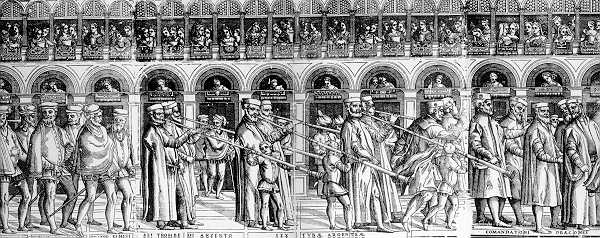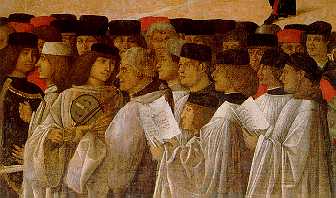
The importance of non-liturgical forms in the repertories composed for and performed by the cappella marciana is underlined by the centrality of the official procession, the andata, in Venetian life. As Edward Muir has emphasised, with its three clearly-differentiated segments, each of which were organised in order of precedence, it is possible to see the andata as a presentation, in visual form, of the hierarchic conception of the Republic.(20) Here too the question of intended audience also arises. No other Italian city required its senior officials to be present on a large number of days during the year (by the end of the sixteenth century more than forty) in order to process. And who was present for these spectacles? Surely not the Venetians, who must have become quite bored by them. For whom did Matteo Pagan produce his set of engravings, eight sheets which when put together represent and identify the participants in the andata in the Piazza San Marco on Palm Sunday? Again it is difficult to believe that these were primarily directed at a Venetian market; at least some buyers must have been tourists or pilgrims rather than natives. It may be relevant that the increase in the number of official processions, and to some extent of the elaboration of Venetian ceremonial in general, coincides with the popularisation, through printed exposition, of Venetian political theory.

Matteo Pagan: Procession in St. Mark's Square, c. 1550 (detail).
Although the andata was undoubtedly both exclusive and hierarchical, it should be remembered that on many occasions its basic arrangement was supplemented by the addition of other social groupings such as the scuole grandi, the trade guilds or even a particular parish. If, in its basic form, the procession presented a visual analogy to the constitution of the Republic, the addition of these other groupings simply broadened participation and was presumably intended to underline the allegedly harmonious corporate social organisation of the city. At the same time, it often expanded its frame of reference by including various additional musical and religious elements. For example, on many of the more important feasts in the Venetian calendar, the cappella marciana participated in the andata; so did the singers employed by some of the wealthier scuole as their participation in the public ceremonial life of the city became even more pronounced in the course of the sixteenth century.(21) In Gentile Bellini's painting showing the Scuola di San Giovanni carrying their prized relic of the True Cross in the official procession in the Piazza on the feastdeay of St, Mark (25 April), a group of five singers are shown accompanied by an instrumental group comprising rebec, lute and harp.(22)

Gentile
Bellini: Procession in St. Mark's Square,
1496 (detail showing singers and instrumentalists).
Venice, Accademia.
In their expanded form, as on this occasion, these processions were also essentially para-liturgical, a way of amplifying the liturgy outside the Basilica by making use of the central civic space of the city and, occasionally, other areas as well. In this way civic and liturgical acts which were usually associated with Dogal authority were able to broaden their audience who could participate not only passively (by observing) but also actively by joining in the chanting of the litanies which were a standard feature of these processions. In this context, it is also worth remembering the fundamental point that the andata carried the patriarchino with it: in consequence, when Mass was celebrated as part of the Dogal andata to a particular church, it was done so according to a liturgy that was exclusively associated with the Basilica. In this symbolic practice the use of the patriarchino once more served to emphasise the Doge's authority over the clergy of the city.